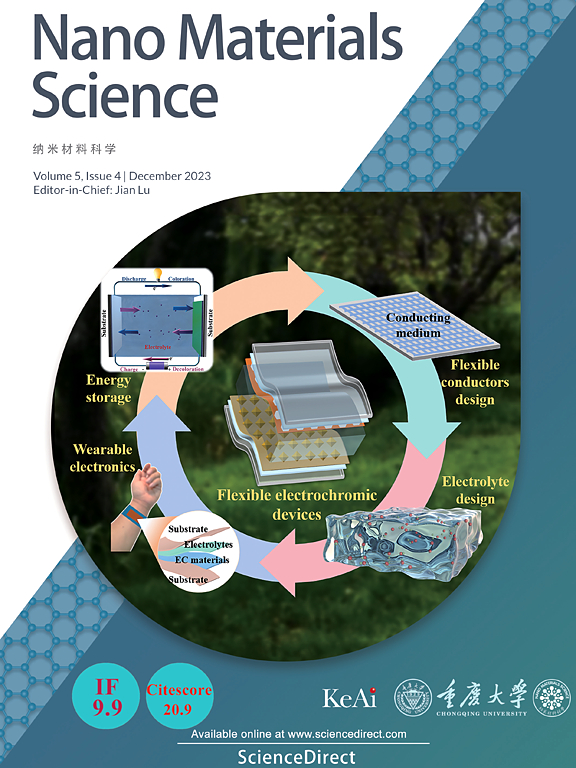利用 NELIBS 在界面自组装等离子纳米层以灵敏检测水中的重金属
IF 17.9
2区 材料科学
Q1 Engineering
引用次数: 0
摘要
目前,高稳定、超灵敏的重金属检测在水质监测中具有重要意义。纳米粒子增强激光诱导击穿光谱(NELIBS)在危险金属检测中显示出巨大的潜力,但由于分析物分布不均匀,导致信号不稳定和微弱。在此,我们开发了一种界面自组装(ISA)方法,在液-液界面上创建均匀分布的金纳米层,用于正重金属离子捕获和NELIBS分析。在环己烷-金纳米粒子水溶液中注入乙醇,在油水界面处制备了静电自组装金纳米粒子(NPs)膜。然后,将界面自组装的Au nps分析物膜转化为激光处理的超亲水性Si载玻片进行检测。对三种重金属(镉(Cd)、钡(Ba)和铬(Cr))进行了分析,以评价ISA方法对NELIBS的稳定性和灵敏度。结果(Cd: RSD = 3.6%, LoD = 0.654 mg/L;Ba: RSD = 3.4%, LoD = 0.236 mg/L;Cr: RSD = 7.7%, LoD = 1.367 mg/L)表现出信号增强、高稳定、超灵敏的检测效果。实际样品检测结果(Cd: RE = 7.71%, Ba: RE = 6.78%)具有较高的可靠性。ISA方法使np分析物在界面上均匀分布,在NELIBS中具有很好的应用前景。本文章由计算机程序翻译,如有差异,请以英文原文为准。
Interface self-assembly of plasmonic nanolayer for sensitive detection of heavy metals in water using NELIBS
Nowadays, high-stable and ultrasensitive heavy metal detection is of utmost importance in water quality monitoring. Nanoparticle-enhanced laser-induced breakdown spectroscopy (NELIBS) shows high potential in hazardous metal detection, however, encounters unstable and weak signals due to nonuniform distribution of analytes. Herein, we developed an interface self-assembly (ISA) method to create a uniformly distributed gold nanolayer at a liquid-liquid interface for positive heavy metal ions capture and NELIBS analysis. The electrostatically self-assembled Au nanoparticles (NPs)-analytes membrane was prepared at the oil-water interface by injecting ethanol into the mixture of cyclohexane and Au NPs-analytes water solution. Then, the interface self-assembled Au NPs-analytes membrane was transformed onto a laser-processed superhydrophilic Si slide for detection. Three heavy metals (cadmium (Cd), barium (Ba), and chromium (Cr)) were analyzed to evaluate the stability and sensitivity of the ISA method for NELIBS. The results (Cd: RSD = 3.6 %, LoD = 0.654 mg/L; Ba: RSD = 3.4 %, LoD = 0.236 mg/L; Cr: RSD = 7.7 %, LoD = 1.367 mg/L) demonstrated signal enhancement and high-stable and ultrasensitive detection. The actual sample detection (Cd: RE = 7.71 %, Ba: RE = 6.78 %) illustrated great reliability. The ISA method, creating a uniform distribution of NP-analytes at the interface, has promising prospects in NELIBS.
求助全文
通过发布文献求助,成功后即可免费获取论文全文。
去求助
来源期刊

Nano Materials Science
Engineering-Mechanics of Materials
CiteScore
20.90
自引率
3.00%
发文量
294
审稿时长
9 weeks
期刊介绍:
Nano Materials Science (NMS) is an international and interdisciplinary, open access, scholarly journal. NMS publishes peer-reviewed original articles and reviews on nanoscale material science and nanometer devices, with topics encompassing preparation and processing; high-throughput characterization; material performance evaluation and application of material characteristics such as the microstructure and properties of one-dimensional, two-dimensional, and three-dimensional nanostructured and nanofunctional materials; design, preparation, and processing techniques; and performance evaluation technology and nanometer device applications.
 求助内容:
求助内容: 应助结果提醒方式:
应助结果提醒方式:


